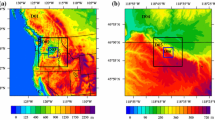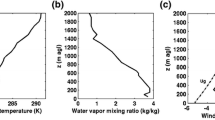Abstract
We implemented the Weather Research and Forecast (WRF) model and WRF Large-Eddy Simulation (WRF–LES), focusing on calculations for the planetary boundary layer (PBL), and compared the results against a data set of a well-documented campaign, in the Houston–Galveston area, Texas, in summer 2006. A methodology using WRF in a mesoscale and LES was implemented to assess the performance of the model in simulating the evolution and structure of the PBL over Houston during the Vertical Mixing Experiment. Also, the WRF model in a real case mode was examined to explore potential differences between the results of each simulation approach. We analyzed both WRF results for key meteorological parameters like wind speed, wind direction and potential temperature, and compared the model results against the observations. The reasonably good agreement of LES results forced with observed surface fluxes provides confidence that LES describes turbulence quantities such as turbulent kinetic energy correctly and warrants further turbulence structure analysis. The LES results indicate a weak but noticeable nighttime turbulent kinetic energy which was produced by wind shear in Houston’s planetary boundary layer and which may likely be related to intermittent turbulence. This is supported by observations made at the University of Houston Moody Tower air quality station when intermittent peaks of carbon monoxide occurred in the evening, although the variability in wind conditions was very little.









Similar content being viewed by others
References
Skamarock WC, Klemp JB, Dudhia J, Gill DO, Barker DM, Duda MG, Huang H-Y, Wang W, Powers JG (2008) A description of the advanced research WRF version 3. NCAR Tech. Note NCAR/TN-475STR. 113
Deardorff JW (1970) Preliminary results from numerical integrations of the unstable planetary boundary layer. J Atmos Sci 27:1209–1211
Deardorff JW (1972) Numerical investigation of neutral and unstable planetary boundary layers. J Atmos Sci 29:91–115
Deardorff JW (1974) Three-dimensional numerical study of turbulence in an entraining mixed layer. Bound-Layer Meteorol 7:199–226
Siebesma AP, Brown CSBA, Chlond A, Cuxart J, Duynkerke P, Jiang H, Khairoutdinov M, Lewellen D, Moeng CH, Sanchez E, Stevens B, Stevens DE (2003) A large-eddy simulation study of shallow cumulus convection. J Atmos Sci 60:1201–1219
Moeng C-H, Cotton WR, Bretherton C, Chlond A, Khairoutdinov M, Krueger S, Lewellen WS, MacVean MK, Pasquier JRM, Rand HA, Siebesma AP, Stevens B, Sykes RI (1996) Simulations of a stratocumulus-topped planetary boundary layer: intercomparison among different numerical codes. Bull Am Meteor Soc 77:261–278
Bryan G, Skamarock W, Rotunno R (2008) A conceptual framework for the resolution dependence of updraft properties in cloud system resolving models. Eos Trans Am Geophys Union 89:53 (Abstract A43G-07)
Stevens DE, Bretherton CS (1999) Effects of resolution on the simulation of stratocumulus entrainment. Q J R Meteor Soc 125:425–439
Markowski PM, Bryan GH (2016) LES of laminar flow in the PBL: a potential problem for convective storm simulations. Mon Weather Rev 144:1841–1850. https://doi.org/10.1175/MWR-D-15-0439.1
Oke TR (1988) Street design and urban canopy layer climate. Energy Build 11:103–113
Talbot C, Leroy C, Augustin P, Willart V, Delbarre H, Fourmentin M, Khomenko G (2007) Transport and dispersion of atmospheric sulphur dioxide from an industrial coastal area during a sea-breeze event. Atmos Chem Phys Discuss 7:15989–16022
Moeng C, Dudhia J, Klemp J, Sullivan P (2007) Examining two-way grid nesting for large eddy simulation of the PBL using the WRF model. Mon Weather Rev 135:2295–2311
Mirocha J, Lundquist J, Kosovic B (2010) Implementation of a nonlinear subfilter turbulence stress model for large-eddy simulation in the advanced research WRF model. Mon Weather Rev 138:4212–4228
Kirkil G, Mirocha J, Bou-Zeid E, Chow FK, Kosovic B (2012) Implementation and evaluation of dynamic subfilter-scale stress models for large-eddy simulation using WRF. Mon Weather Rev 140:266–284
Gibbs JA, Fedorovich E (2014) Comparison of convective boundary layer velocity spectra retrieved from large-eddy-simulation and weather research and forecasting model data. J Appl Meteor Climatol 53:377–394
Caicedo V, Rappenglueck B, Lefer B, Morris G, Toledo D, Delgado R (2017) Comparison of aerosol LIDAR retrieval methods for boundary layer height detection using ceilometer backscatter data. Atmos Meas Tech. https://doi.org/10.5194/amt-10-1609-2017
Czader BH, Li X, Rappenglück B (2013) CMAQ modeling and analysis of radicals, radical precursors and chemical trans-formations. J Geophys Res 118:11376–11387. https://doi.org/10.1002/jgrd.50807
Cuchiara GC, Li X, Carvalho J, Rappenglück B (2014) Intercomparison of planetary boundary layer parameterization and its impacts on surface ozone concentration in the WRF/Chem model for a case study in Houston/Texas. Atmos Environ 96:175–185. https://doi.org/10.1016/j.atmosenv.2014.07.013
Lefer B, Rappenglück B (2010) The TexAQS-II radical and aerosol measurement project (TRAMP) Preface. Atmos Environ 44:3997–4004
Rappenglück B, Perna R, Zhong S, Morris GA (2008) An analysis of the vertical structure of the atmosphere and the upper-level meteorology and their impact on surface ozone levels in Houston, Texas. J Geophys Res 113:D17315. https://doi.org/10.1029/2007JD009745
Wilmot C-SM, Rappenglück B, Li X, Cuchiara GC (2014) MM5 v3.6.1 and WRF v3.2.1 model comparison of standard and surface energy variables in the development of the planetary boundary layer. Geosci Model Dev Discuss 7:2705–2743
Ngan F, Byun D, Kim H, Lee D, Rappenglück B, Pour-Biazar A (2012) Performance assessment of retrospective meteorological inputs for use in air quality modeling during TexAQS 2006. Atmos Environ 54:86–96
Ngan F, Kim H, Lee P, Al-Wali K, Dornblaser B (2013) A study of nocturnal surface wind speed overprediction by the WRF-ARW model in southeastern Texas. J Appl Meteol Climatol 52:2638–2653. https://doi.org/10.1175/JAMC-D-13-060.1
Yamaguchi T, Feingold G (2012) Technical note: large-eddy simulation of cloudy boundary layer with the Advanced Research WRF model. J Adv Model Earth Syst 4:M09003. https://doi.org/10.1029/2012MS000164
Khairoutdinov MF, Randall DA (2003) Cloud resolving modeling of the ARM summer 1997 IOP: model formulation, results, uncertainties, and sensitivities. J Atmos Sci 60:607–625. https://doi.org/10.1175/1520-0469(2003)060,0607:CRMOTA2.0.CO;2
Kumar V, Kleissl J, Meneveau C, Parlange MB (2006) Large-eddy simulation of a diurnal cycle of the atmospheric boundary layer: atmospheric stability and scaling issues. Water Resour Res 42:W06D09. https://doi.org/10.1029/2005wr004651
Basu S, Vinuesa J, Swift A (2008) Dynamic LES modeling of a diurnal cycle. J Appl Meteorol Climatol 47:1156–1174. https://doi.org/10.1175/2007JAMC1677.1
Clements CB, Zhong S, Goodrick S, Li J, Potter BE, Bian X, Heilman WE, Charney JJ, Perna R, Jang M, Lee D, Patel M, Street S, Aumann G (2007) Observing the dynamics of wildland grass fires—FireFlux—a field validation experiment. Bull Am Meteorol Soc 88:1369–1382. https://doi.org/10.1175/BAMS-88-9-1369
Zhong S, In HJ, Clements C (2007) Impact of turbulence, land surface, and radiation parameterizations on simulated boundary layer properties in a coastal environment. J Geophys Res 112:D13110. https://doi.org/10.1029/2006JD008274
Yamada T (1979) Prediction of the nocturnal surface inversion height. J Appl Meteorol 18:526–532
Sorbjan Z (1996) Numerical study of penetrative and “Solid Lid” nonpenetrative convective boundary layers. J Atmos Sci 53:101–112
Chen F, Manning KW, LeMone MA, Trier SB, Alfieri JG, Roberts R, Blanken PD (2007) Description and evaluation of the characteristics of the NCAR high-resolution land data assimilation system. J Appl Meteorol Climatol 46(6):694–713
Sharma A, Fernando HJ, Hamlet AF, Hellmann JJ, Barlage M, Chen F (2017) Urban meteorological modeling using WRF: a sensitivity study. Int J Climatol 37(4):1885–1900. https://doi.org/10.1002/joc.4819/full
Liu Y, Chen F, Warner T, Basara J (2006) Verification of a mesoscale data-assimilation and forecasting system for the Oklahoma City area during the Joint Urban 2003 field project. J Appl Meteorol Climatol 45(7):912–929
Lee SH, Kim SW, Angevine WM, Bianco L, McKeen SA, Senff CJ, Trainer M, Tucker SC, Zamora RJ (2011) Evaluation of urban surface parameterizations in the WRF model using measurements during the Texas Air Quality Study 2006 field campaign. Atmos Chem Phys 11(5):2127–2214
Chen F, Kusaka H, Bornstein R, Ching J, Grimmond CSB, Grossman-Clarke S, Zhang C (2011) The integrated WRF/urban modelling system: development, evaluation, and applications to urban environmental problems. Int J Climatol 31:273–288
LeMone M, Chen F, Tewari M, Dudhia J, Geerts B, Miao Q, Coulter R, Grossman R (2009) Simulating the IHOP_2002 fair-weather CBL with the WRF-ARW-Noah modeling system. Part1: surface fluxes and CBL Structure and evolution along the eastern track. Mon Weather Rev 138:722–744
Luke WT, Kelley P, Lefer BL, Flynn J, Rappenglück B, Leuchner M, Dibb JE, Ziemba LD, Anderson CH, Buhr M (2010) Measurements of primary trace gases and NOy composition in Houston, Texas. Atmos Environ 44:4068–4080. https://doi.org/10.1016/j.atmosenv.2009.08.014
Flynn J, Lefer B, Rappenglück B, Leuchner M, Perna R, Dibb J, Ziemba L, Anderson C, Stutz J, Brune W, Ren X, Mao J, Luke W, Olson J, Chen G, Crawford J (2014) Impact of clouds and aerosol on ozone production in southeast Texas. Atmos Environ 44:4126–4133. https://doi.org/10.1016/j.atmosenv.2009.09.005
Hines CO (1972) Gravity waves in the atmosphere. Nature 239:73. https://doi.org/10.1038/239073a0
Gossard E, Munk W (1954) On gravity waves in the atmosphere. J Meteorol 11:259–269. https://doi.org/10.1175/1520-0469(1954)011
Einaudi F, Lalas DP, Perona GE (1976) The role of gravity waves in tropospheric process. Pure Appl Geophys 117:627–663
Rappenglück B, Reitmayer H, Fabian P (2000) On the use of manned hydrogen gas ballooning in boundary layer studies. Environ Sci Pollut Res 7:211–218
Mahrt L (1999) Stratified atmospheric boundary layers. Bound Layer Meteorol 90:375–396. https://doi.org/10.1023/a:1001765727956
Vilà-Guerau de Arellano J, Gioli B, Miglietta F, Jonker H, Baltink H, Hutjes R, Holtslag A (2004) Entrainment process of carbon dioxide in the atmospheric boundary layer. J Geophys Res 109:D18110
Casso-Torralba P, Vila-Guerau de Arellano J, Bosveld F, Soler MR, Vermeulen A, Werner C, Moors E (2008) Diurnal and vertical variability of the sensible heat and carbon dioxide budgets in the atmospheric surface layer. J Geophys Res 113:D12119. https://doi.org/10.1029/2007JD009583
Blay-Carreras E, Pino D, Vilà-Guerau de Arellano J, van de Boer A, De Coster O, Darbieu C, Hartogensis O, Lohou F, Lothon M, Pietersen H (2014) Role of the residual layer and large-scale subsidence on the development and evolution of the convective boundary layer. Atmos Chem Phys 14:4515–4530. https://doi.org/10.5194/acp-14-4515-2014
Acknowledgements
We acknowledge the financial support provided by the Coordination for the Improvement of Higher Education Personnel (CAPES). We gratefully acknowledge financial and logistic support of the Houston Advanced Research Center (HARC) (Grant No.: H78 Modification C (582-4-65587)), the Texas Commission on Environmental Quality (TCEQ) (Grant No.: 582-5-64594-01), and the University of Houston to obtain the data within the TRAMP study.
Author information
Authors and Affiliations
Corresponding author
Rights and permissions
About this article
Cite this article
Cuchiara, G.C., Rappenglück, B. Performance analysis of WRF and LES in describing the evolution and structure of the planetary boundary layer. Environ Fluid Mech 18, 1257–1273 (2018). https://doi.org/10.1007/s10652-018-9597-5
Received:
Accepted:
Published:
Issue Date:
DOI: https://doi.org/10.1007/s10652-018-9597-5




